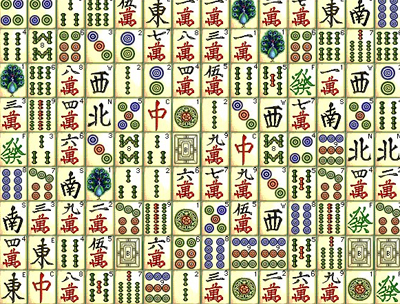Mahjong
Sometimes it is played as a gambling game. Tactics, observation and memory are required to master the game.
A mahjong game may contain 136, 144, 148 or 152 tiles, the most common being 136 and 144.
The tiles are grouped into Suits (consisting of Dot- or Circle tiles, Bamboo tiles and Character tiles) Honour (consisting of Wind tiles and Dragon Tiles) and Flower (consisting of Flower tiles and Seasonal tiles).
A set of 144 Mahjong tiles consists of 36 tiles in the Dot/ Circle suit, 36 in the Bamboo suit, 36 in the Character suit, 16 Wind tiles, 12 Dragon tiles and 8 bonus tiles (4 Flowers and 4 Seasons).
Players are seated around a squared table, signifying the four directions East, South, West, North.
AIM OF THE GAME
One receives either thirteen or sixteen tiles for a hand (depending on the variation being played), remaining tiles are placed in the middle. When ones turn comes, one draws a tile and discards one. The goal is to make four “melds” (certain set of tiles) and an identical pair of any suit, or "head". (Note that a winning hand contains fourteen tiles. One wins by drawing a tile that completes your hand, or of someone else's discard.)
SYMBOLISM IN MAHJONG TILES
SUIT
The Suits of the tiles (Dot/ Circle, Character, Bamboo) are money-based. In ancient China, the copper coins had a square hole in the centre. People passed a rope through the holes to tie coins into strings. These strings are usually in groups of 100 coins (called diao) or 1000 coins (called guan).
DOT/ CIRCLE
Each tile consists of a number of circles, each circle represents one copper coin.
CHARACTERS
Named as each tile represents ten thousand coins, or one hundred strings of one hundred coins.
BAMBOO
Named as each tile (except the Bamboo 1 which has a bird sitting on a bamboo) consists of a number of bamboo sticks. Each stick is said to represent a string that holds a hundred coins.
HONOUR TILES
WIND
A further category of tiles would be the four Honour tiles, each representing one direction, namely East, South, West and North (see also: Five Elements Chart).
DRAGON
Dragon tiles: red, green, and white.
It is said that the three dragon tiles represent the Cardinal Virtues bequeathed by Confucius: red- benevolence, green- sincerity, white- filial piety.
The term dragon tile is a western convention introduced by Joseph Park Babcock in his 1920 book introducing Mahjong to America. Originally, these tiles are said to have something to do with the Chinese Imperial Examination. The red tile means you pass the examination and thus will be appointed a government official. The green tile means, consequently you will become financially well off. The white tile means that because a person is doing well they should act like a good, incorruptible official. It usually has a blue border to distinguish from replacement tiles and prevent players from secretly adding lines to effect a victory.
(See also Dragons)
FLOWER TILES
FLOWER
Flower tiles are typically optional components to a set of mahjong tiles, these tiles often contain artwork on their tiles. Many people prefer not to use these tiles due to the fact that they make it easier to win and earn bonus points. For example, if you have no flowers in your hand you get 1 bonus point.
Typical flower tiles represent plum (梅 méi), orchid (蘭 lán), chrysanthemum (菊 jú), and bamboo (竹 zhú). (See also Flowers Symbolism)
SEASONAL
Seasonal tiles representing spring, summer, autumn, and winter (see also: Bagua).
Note: Characters shown on the picture are Dragon, Flower, Dots/ Circles, Character, Bamboo (left- right, top upper corner- bottom)

Mahjong tiles
|





